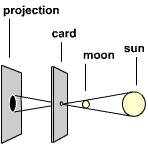The Transit Of Venus
Created | Updated Jun 9, 2004

The History of the Transit of Venus
In 1639, Jeremiah Horrocks, a curate in Lancashire, was the first person to accurately predict the date on which the planet Venus would cross the face of the sun. In that year only Horrocks and his friend William Crabtree of Manchester are known to have seen the transit taking place. However, Horrocks predicted that the next transits would take place on June 6th 1761, and June 3rd 1769.
In 1761, 176 astonomers were watching the skies at 117 locations across the world. The results were very disappointing, due to 'cloudy weather and other unfavourable causes'. Astronomers resolved to take more strenuous efforts in 1769.
The transit in 1769 started just after 7 pm, and was witnessed by a great number of people including Gilbert White in Selborne.
What is the Transit of Venus?
The Transit of Venus is a type of eclipse, where the planet Venus travels across the face of the sun. Venus transits occur in pairs: In Gilbert White's lifetime they were in 1761 and 1769. The first of the pair occurs in 2004 on 8th June, and the next one is in 2012, on June 5th - 6th. There are intervals between the transits of 121 and 105 years.
The transit can only be seen during daylight hours and this year the entire transit was visible from the UK. However, in 2012, we will only be able to observe the last hour of the transit at sunrise, as the main part of the eclipse will take place overnight on the 5th - 6th of June.
White was only able to see the beginning of the transit in 1769, just as the sun set - before that, the last wholly visible transit of Venus was in 1283 AD.
What Did Gilbert White See in 1769?
Saturday 3 June:
'Saw the planet Venus enter the disk of the sun. Just as the sun was setting, the spot was very visible to the naked eye.'
The sun would have been setting in the west during the transit, so it would have only been visible for about an hour. Gilbert White was almost certainly in his garden while he watched the transit: he may have watched it from the Quincunx, as the sun disappeared behind the west end of the Hanger.
June 8th 2004
In the early morning of the 8th June in 2004, the transit began. The sun rose at 4:45 am and Venus first began its pass in front of the sun at 6:19 am. By 9:26 am it was halfway across the face of the sun, and it finished its transit at 12:32 pm.
It was difficult to predict the exact time at which the planet would cross on to the sun, as your location affected your viewing angle. From Selborne, Venus appeared to cross over a few minutes later than the scheduled time.
What Did the Transit Look Like?
Venus appeared as a small dot on the sun. In comparison, it was like trying to see a penny from 50 metres away.
One way to have safely viewed the Transit of Venus was by using a simple pinhole viewer1. A pinhole in a piece of card will project an upside-down image on to another piece of card held behind it. Alter the distance between the two pieces of card to focus, enlarge or brighten the image.
Why Was the Transit of Venus So Important?
The great number of observers, including Gilbert White, contributed to a significant scientific finding. By timing and measuring the path of Venus across the sun, the results from the many observers combined to enable the calculation of the distance between the Earth and the Sun.
Edmond Halley had realised in 1677 that by exactly measuring the transit of Venus, it would be possible to calculate the Solar Parallax or distance to the Sun. Although Halley knew he would not live to see the transit, his detailed plans and paper ensured that expeditions were sent out to far corners of the Earth to make observations.
Difficulties with discerning the exact moment at which the contact took place led to some small inaccuracies, but it could then be said the the real distance from the Earth to the Sun, the 'Astronomical Unit', was truly known. From this, the exact dimensions of our Solar System could be calculated.
